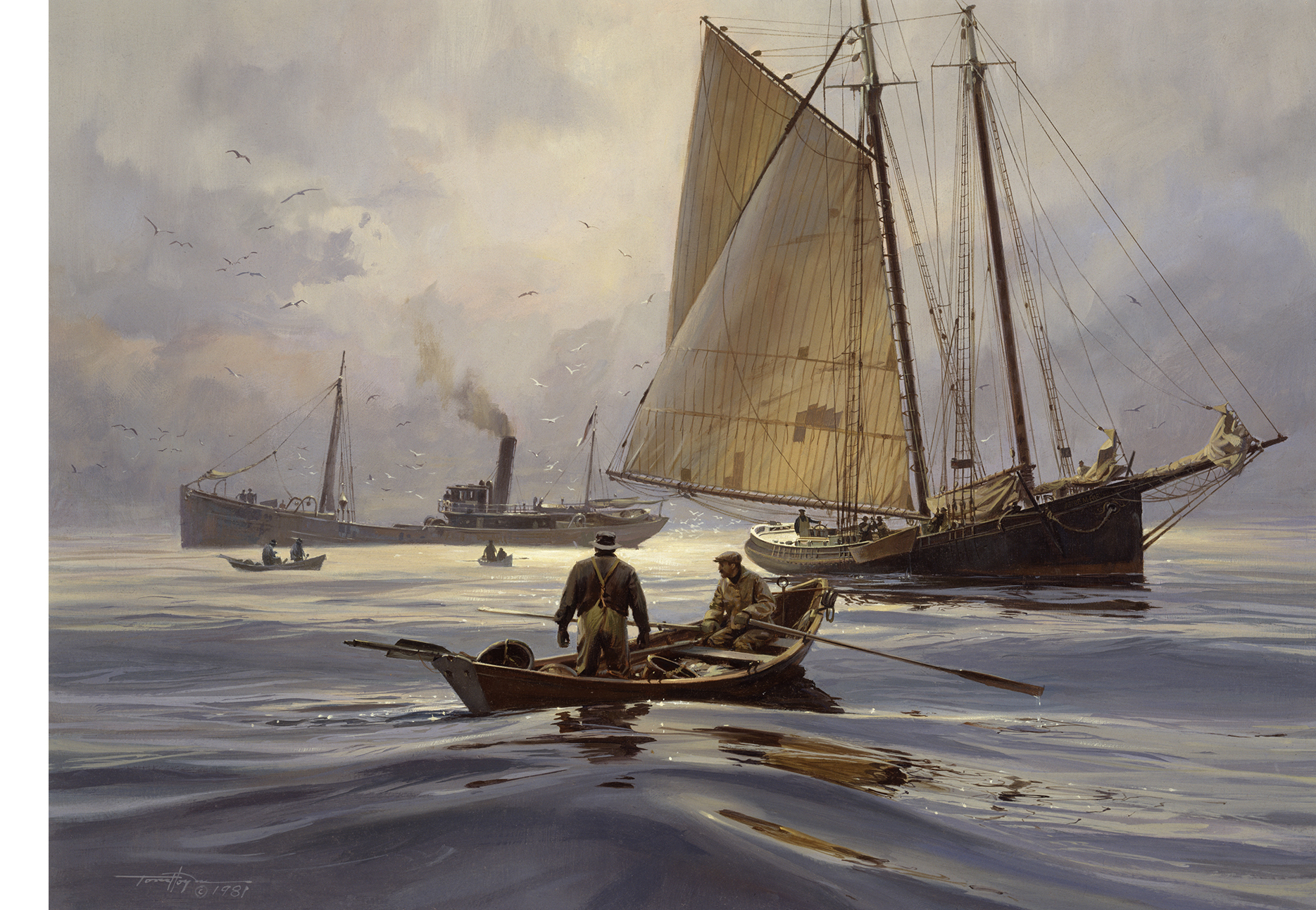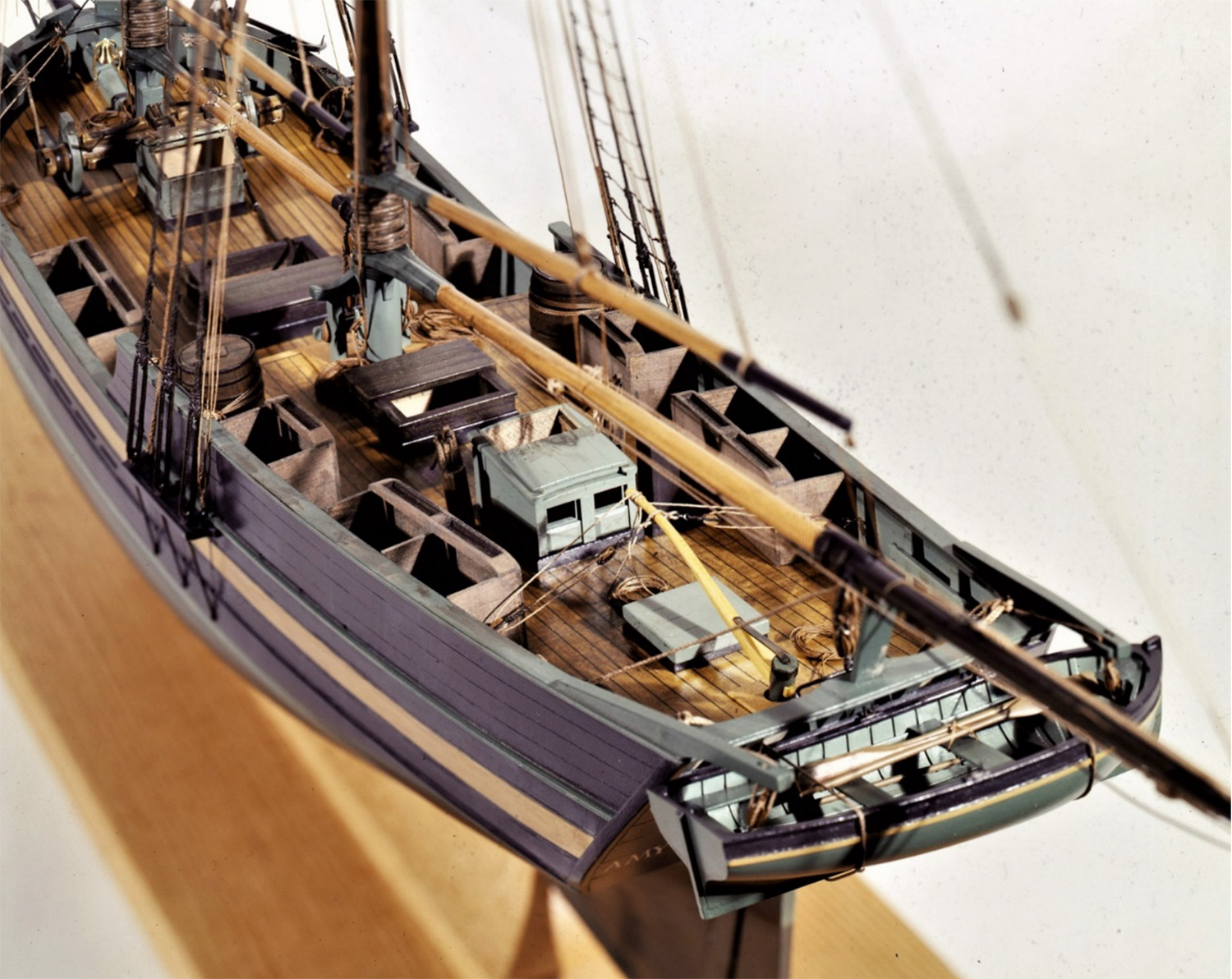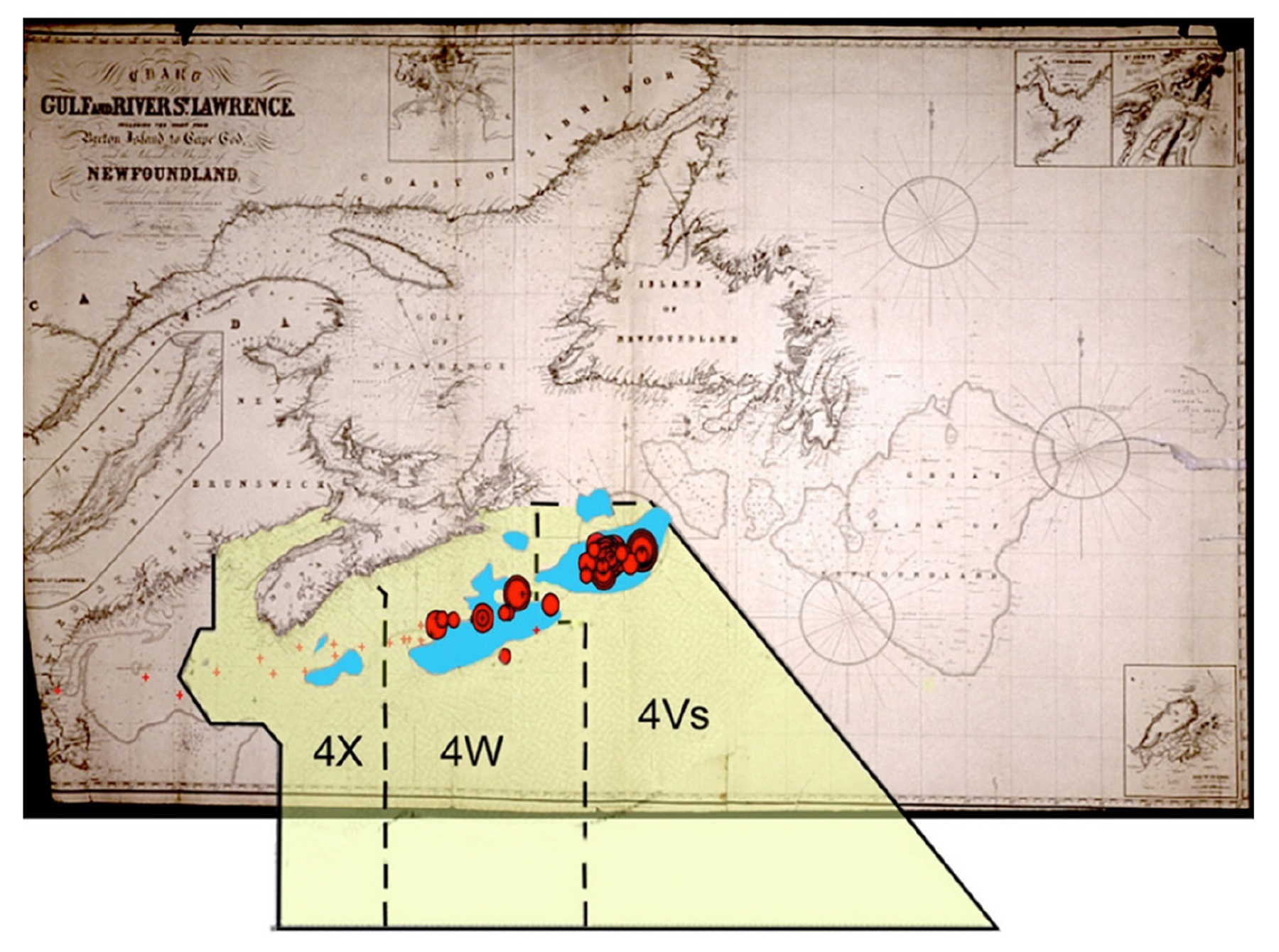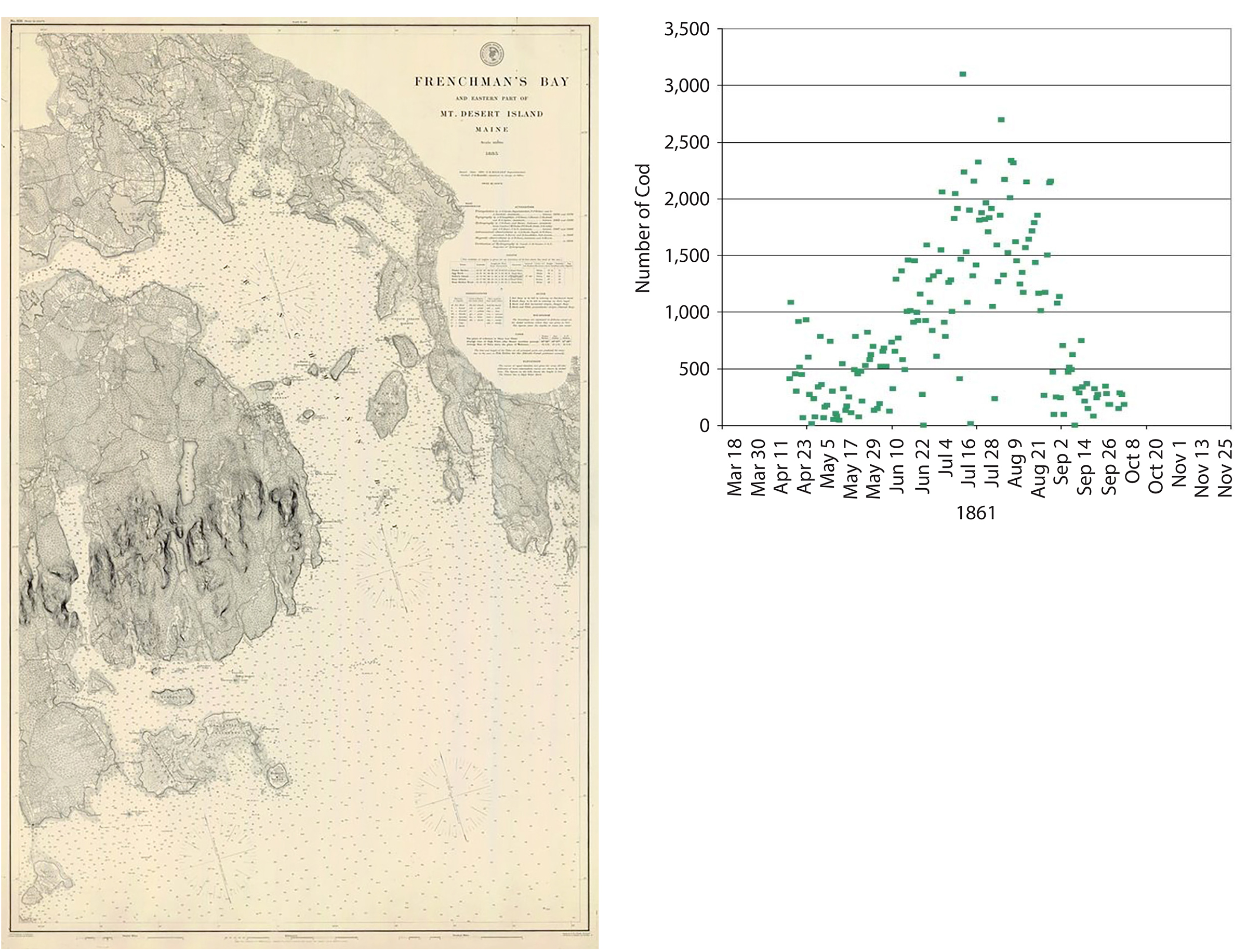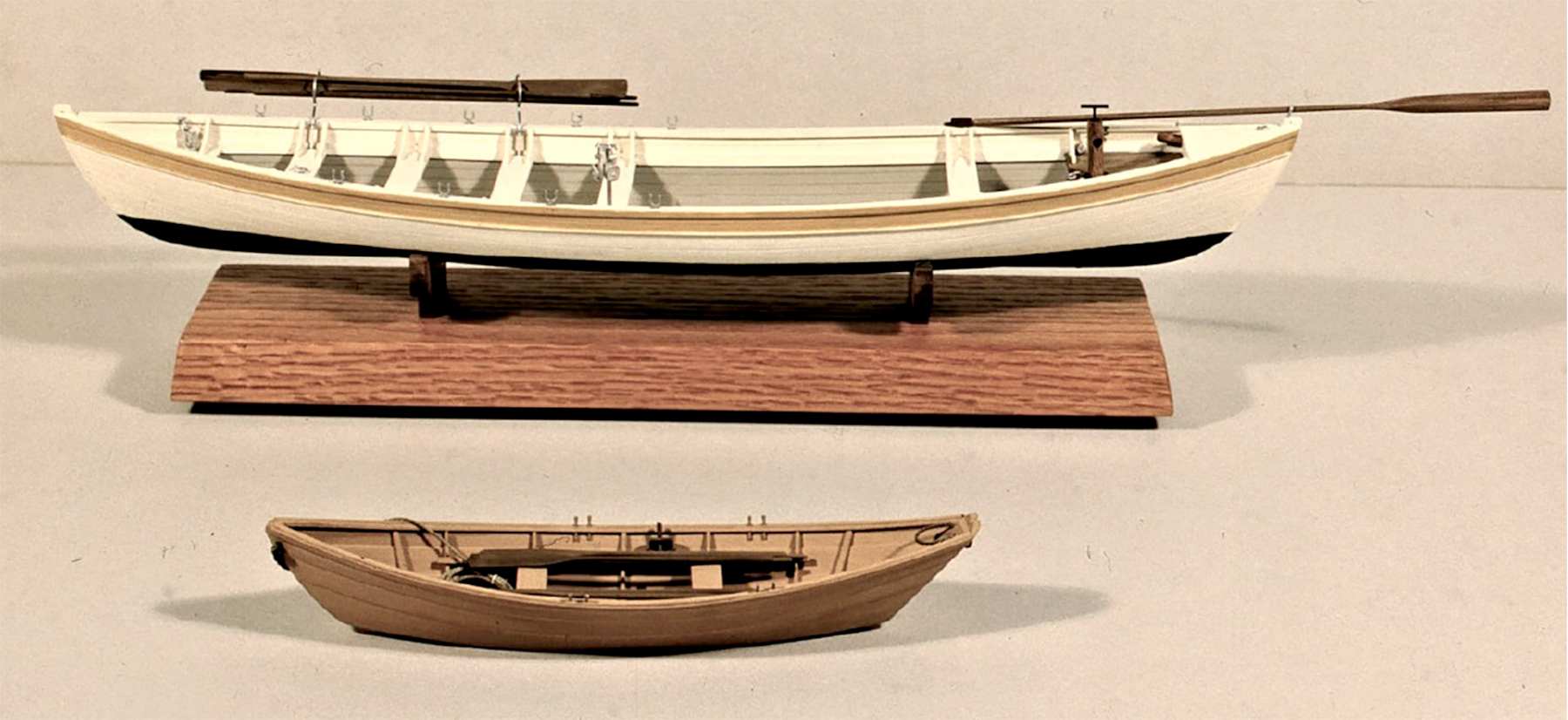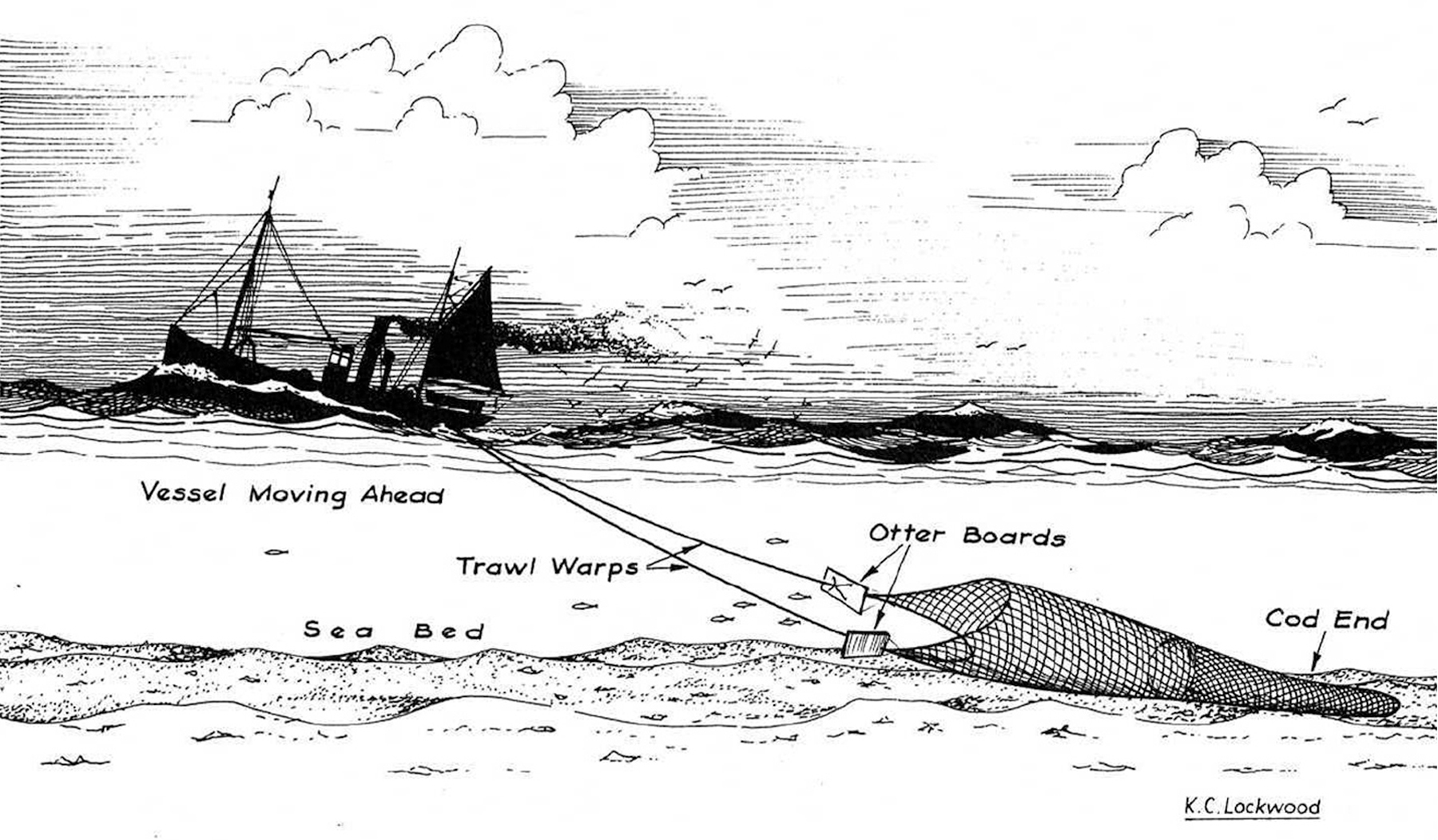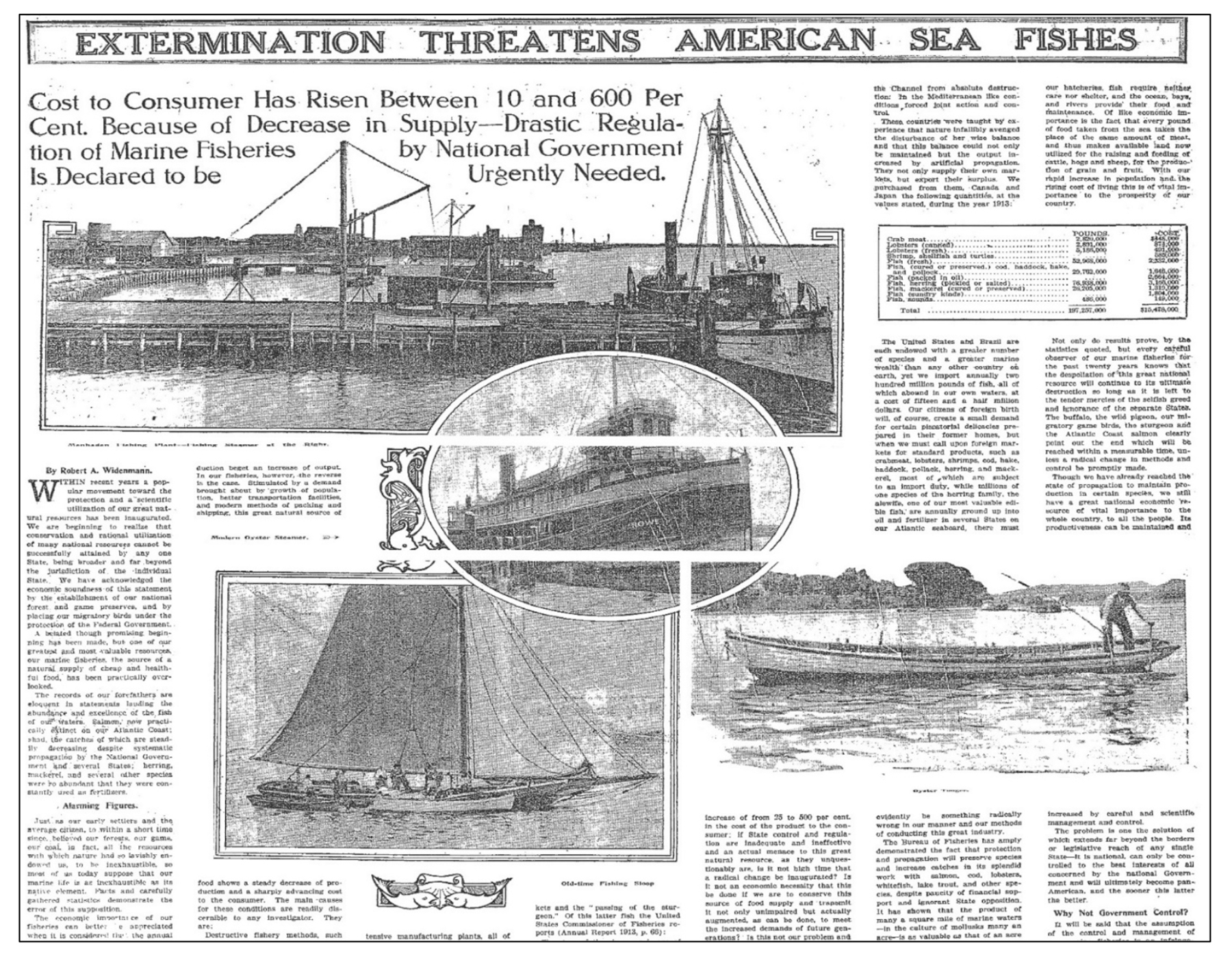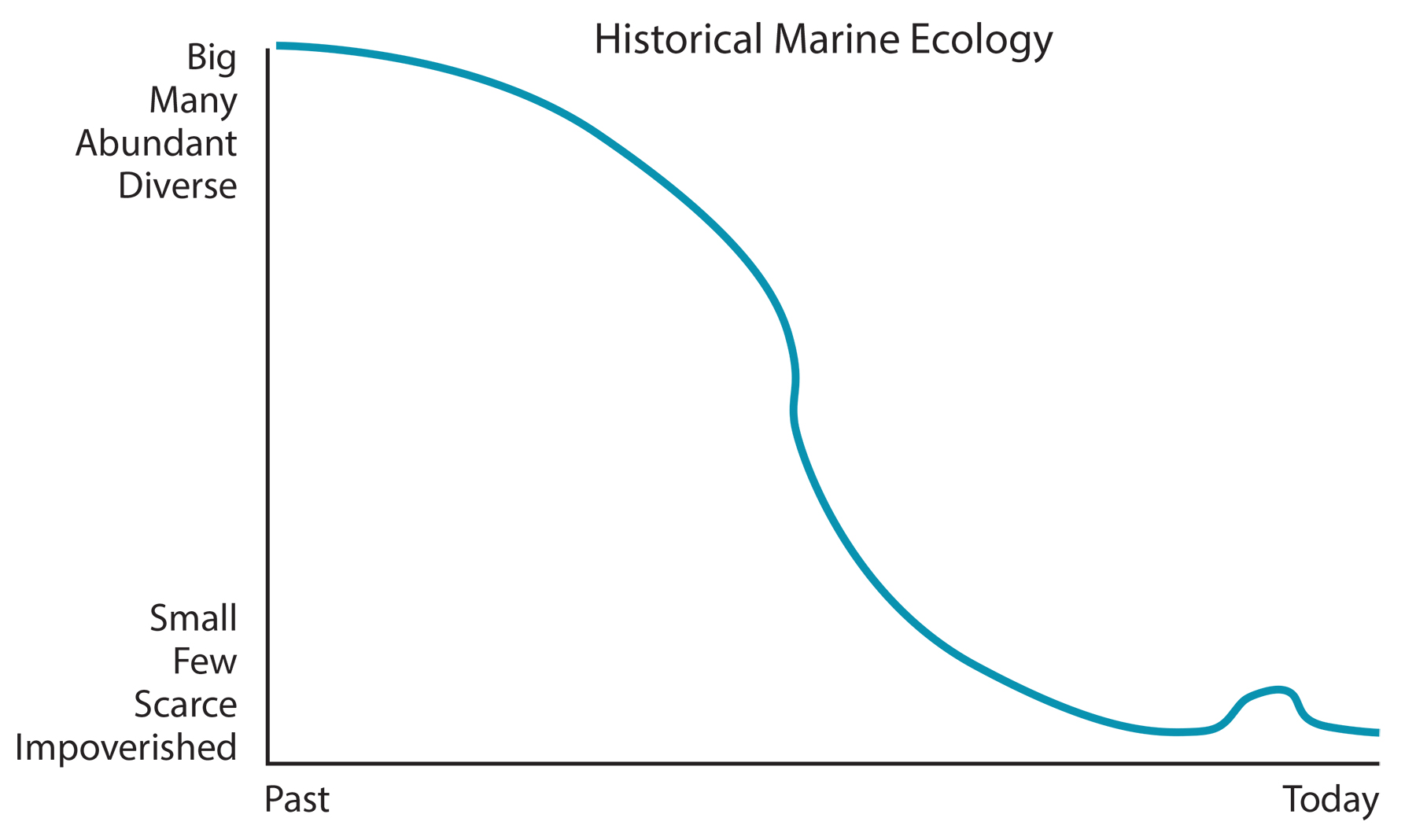Full Text
The Roger Revelle Commemorative Lecture Series was created by the Ocean Studies Board of the National Academies in honor of Roger Revelle to highlight the important links between ocean sciences and public policy. W. Jeffrey Bolster, the nineteenth annual lecturer, spoke on April 25, 2018, at the National Academy of Sciences.
Most fishermen initially feared destructive trawling technology and resisted it. This painting imagines the first encounter of schooner fishermen with a steam trawler, which took place in the Western Hemisphere shortly after the 1905 launch of the steamer Spray. Thomas M. Hoyne, New Ways on Quero Bank, 1981; courtesy of Doris O. Hoyne and the Peabody Essex Museum, Salem, MA; Gift of Russell W. Knight, 1982. > High res figure |
|
By inviting a historian to deliver the 2018 Roger Revelle Lecture, the Ocean Studies Board signals the value of fruitful engagement between the sciences and the humanities. Their decision honors Roger Revelle’s legacy. A brilliant geophysicist and oceanographer, Revelle embraced interdisciplinary approaches during the final years of his career, turning his attention to malnutrition, global poverty, and education. Roger Revelle recognized that thorny problems require multiple forms of knowledge.
Historians approach the past as if it were a foreign country. Getting there is difficult, understanding what’s encountered even more so (Lowenthal, 1985; Appleby et al., 1994). Evidence is fragmentary, and contexts are crucial. Historical observations are clearly important: anyone seeking perspective on the contemporary fisheries crisis, for instance, or striving to understand how healthy marine ecosystems once functioned, would do well to pay attention to the past. Despite a recent groundswell of interest in historical evidence by some marine scientists, it has yet to penetrate deeply into assessment and policy (Alexander et al., 2011; Kittinger et al., 2014; Engelhard et al., 2016).
We are the first generation to confront numerous distress signals from the living ocean: pollution, habitat destruction, plastic infestation, anoxic zones, overfishing, biological invasions, ocean acidification, and coral bleaching. Worries in the past were more focused—in nineteenth-century America, they revolved around a central question: “Would there be fish for the future?”
It is easy to blame modern technology for ecological problems in the fishery, easy to assume that our problems began with post-World War II factory ships, rugged polyester nets, electronic fish-finders, and pinpoint GPS navigation. Voluminous evidence shows otherwise. Overfishing has deep roots in the Northwest Atlantic, and in much of the world (Jackson et al., 2001; Myers and Worm, 2003; Rosenberg et al., 2005; Lotze et al, 2006; Bolster, 2012). When historical evidence is assessed, one thing becomes readily apparent. The state of marine ecosystems and fisheries is worse than most experts imagine.
American fishermen, scientists, and policymakers have been grappling with fisheries depletion for a very long time. That conversation began in earnest during the 1850s (Figure 1; Bolster, 2012). In 1871, federal politicians commenced spending taxpayers’ dollars to reverse declining catches. Spencer F. Baird, one of the most prominent scientists in America, and the director of the US Commission on Fish and Fisheries, argued shortly thereafter for “the restoration of our exhausted cod fisheries” (USCFF, 1874). It never happened (Figure 2).
|
|
|
|
By the late nineteenth and early twentieth centuries, the US Commission on Fish and Fisheries, and its successor after 1903, the US Bureau of Fisheries, oversaw one of the most generously funded federal research initiatives in the country (Pauly, 2000; Bolster, 2012). Investigators’ data revealed ongoing depletion.
Industrial fishing began in earnest after World War I. Overfishing increased. By the 1950s, foreign factory processing ships were fishing the Northwest Atlantic, further reducing biomass (Warner, 1977). By the time the Magnuson–Stevens Fishery Conservation and Management Act became US law in 1976 (Public Law 94-265) and the 200-mile exclusive economic zone was adopted by the third United Nations Conference on the Law of the Sea in 1982, Northwest Atlantic groundfish stocks were reeling. They have never recovered. Many other fisheries have continued to decline, despite scientific management under revisions of federal fisheries law in the Magnuson-Stevens Act (Pauly and Maclean, 2003; Rose, 2007).
Our twenty-first-century fisheries crisis has been regarded rightfully as an ecological and political problem, but too infrequently understood in light of history—as if nature and science were somehow separate from the study of the past (Bolster, 2006). The lion’s share of marine ecology and fisheries management articles published every year cover only a brief time span. They cannot help but suspend attention to drivers of ecosystem function such as natural variability, historic anthropogenic influences, the presence or absence of certain organisms, long-term climatic cycles, and extreme weather events, among others. Lack of data is clearly a problem, compounded by some researchers’ unwillingness to dig deeply in unfamiliar types of sources, or to imagine how various materials from the past might inform their studies.
Statistical stock assessments remain the gold standard for management decisions, yet they rarely rely on information more than a few decades old. The goal of fishery managers is to sustain the biomass necessary for maximum sustainable yield. Recent data alone, however, and calculations derived from it (no matter how elegant), cannot help but ignore historic ecosystem productivity, along with other aspects of past ecosystem configuration. That leads policymakers, pressured by commercial and community groups, to establish restoration goals reflecting only a fraction of fish abundances once considered normal. Such present-centered approaches lead everyone—scientists, policymakers, and the public—to misapprehend the scale of the problem, and the fact that generations have struggled with it.
I admit candidly that historical evidence is often messy, incomplete, and inconsistent—that it is characterized by uncertainties. Frequently it does not lend itself to quantification. It is often difficult to merge with data recently obtained.
Of course, sophisticated stock assessments and mathematically precise ecosystem modeling are also riddled with uncertainties, depending on the assumptions made, data used, categories of analysis ignored, and hypotheses examined (Link et al., 2012). Each approach, whether by historians or modelers, has uncertainties. They are just different, a result of those practitioners’ training and the material at their disposal. Anthropologist Ruth Benedict pointed out years ago that if we are to truly understand things, “we must know as much about the eye that sees as about the object seen…Means of perception [are] conditioned by the trajectory in which [their] possessor has been reared” (Benedict, 1943). Fisheries management, I suggest, would benefit from openness to more “means of perception.”
Can we expand the definition of what constitutes the “best scientific information available” to include more evidence from the past? A National Academies report in 2004 on improving the best scientific information available took a step in that direction when it referred to the usefulness of anecdotal information in some circumstances. Of course, anecdotes are only one form of historical evidence (NRC, 2004).
The conversation is really about that old question—will there be fish for the future? Managers need tools to help stocks recover. It is easy to make a case that without statistical stock assessment and scientific management since 1976, the state of the fisheries would be considerably worse than it currently is. Pressures from the fishing industry and its lobbyists have been intense. That said, management protocols in place during the last 40 years have not stopped the ongoing degradation of many fisheries. In the face of this continuing problem, methodological change seems warranted.
Meaningful change to the federal fisheries law should include recognition of findings by marine ecologists willing to study past conditions. Historical observations provide sorely needed perspective on rebuilding fish stocks. Clearly, protocols for evaluating such work will need to be developed. While that will be contentious, management approaches honoring different forms of knowledge should contribute to the recovery of living marine resources.
I certainly don’t have all the answers, but I can tell you how we got here.
* * *
From 1639 to 1702, New Englanders passed laws to preserve striped bass, cod, and mackerel, despite the sea of plenty lapping at their feet. We could snort with derision, regarding those colonists as foolish because there were plenty of fish. Or, we could recognize that as emigrants from places with degraded ecosystems, colonials were worried about depletion. Their policies reflected local ecological concerns (Bolster, 2012).
Discernible human impacts on marine ecosystems were apparent by the time of George Washington’s presidency. By then, Atlantic gray whales were extinct. Right whales were greatly reduced. Great auks, the “penguins” of the North Atlantic, were heading for extinction. Other seabirds had been depleted. The abundance and distribution of walrus had been severely reduced, pushing a species once common near Nova Scotia and New Brunswick toward the Arctic. Anadromous fish runs had shrunk.
In 1797, Judge Benjamin Chadbourne described the Salmon Falls River, which flows into the Piscataqua River at the southern part of the border between Maine and New Hampshire: “Formerly, large fish such as salmon, bass and shad came up the river in plenty, but they have forsook it.” A keen observer and life-long resident, Chadbourne, then in his sixties, revealed how fishing had altered the estuarine ecosystem during his lifetime. Evidence from the Northwest Atlantic prior to 1800 reveals that the ecosystem roles of marine mammals, seabirds, and anadromous fish had all been reduced, and that estuarine productivity had been degraded. Such observations are waypoints worth noting (Chadbourne, 1797).
American fishermen ignored menhaden entirely throughout the colonial period, though farmers in Long Island Sound and Narragansett Bay seined them during the late eighteenth century for fertilizer. Menhaden are bony, oily cousins of herring, and forage fish par excellence (Franklin, 2007). Today, industrial fishers seine menhaden to render them into oil and animal or poultry feed. A small-scale menhaden oil-rendering operation began in Rhode Island in 1811, but fishermen in Maine generally continued to ignore those little fish.
That changed in 1850. John Bartlett of Blue Hill, Maine, seined a few baskets of menhaden, which his wife boiled on the beach. She skimmed the oil, and a Boston merchant offered her $11 a barrel. The Bartletts then seined more ambitiously—still with handmade nets from small rowboats and sailboats near shore. Neighbors got involved.
People in Blue Hill had commercialized a previously underutilized resource—a recurring theme in fisheries history. Otherwise, they were doing with menhaden what they and neighbors had done with cod and mackerel for decades. Locals caught nearby fish, packed fish products in barrels, and sent them away for money. It seemed logical and lucrative (Bolster, 2012).
Yet hundreds of fishermen reacted angrily, inundating legislators with petitions. In 1852, Boothbay residents insisted that “taking Menhaden…in our Bays, Rivers, and Harbours is very destructive to said fish and if persisted in will eventually destroy them or drive them from our coast.” Men from Deer Isle, Ellsworth, Surry, and Sedgewick concurred. In 1857, Gouldsboro fishermen, fearing “the material injury of the codfishing interests in this state, requested legislative action to “prevent the future destruction of the menhaden” (MeSA, Legislative Laws, 1852; MeSA, Legislative Graveyard, 1857).
This fury was unlike anything that had previously existed in Maine’s legislative record. Upon encountering it in the archives, I was shocked. Why were so many fishermen angry about the commercialization of menhaden, and the money it was bringing into their hardscrabble towns?
As pieces of the puzzle came together, it became clear that the 1850s was the first decade in which fishermen from Massachusetts, New Hampshire, Maine, Nova Scotia, and New Brunswick organized systematically to express concerns about the future of cod, haddock, and mackerel. Colonials had lamented the demise of anadromous fish—the shad, salmon, sturgeon, and others that ascended rivers to spawn. Those fish were sitting ducks. Not until the 1850s, however, did large numbers of fishermen articulate what they saw as threats to true sea fish. In 1852, the Nova Scotia Assembly debated outlawing the mackerel fishery during spawning season. In 1855, the Maine Legislature prohibited seining mackerel within three miles (4.8 km) of shore—the area it controlled (Bolster, 2012). Historians call what occurred in the 1850s a turning point. By then, the fishing banks seaward of New England and Atlantic Canada had been a coupled human-and-natural system for centuries (Liu et al., 2007).
* * *
As part of the Census of Marine Life, a University of New Hampshire research group of historians and ecologists came together in 2000, committed to interdisciplinary approaches to historic fisheries. We were fortunate to find historical records that could be merged with a modern population dynamics model to create quantifiable data for nineteenth century fisheries. Our results helped explain why fishermen changed their tune during the 1850s. Fishermen felt that catches were declining. They were right.
One of our studies used extraordinarily rich data from 326 fishing schooners from Beverly, Massachusetts, that fished the Nova Scotian Shelf during the 1850s, along with catch records from another 1,313 American schooners also fishing there (Rosenberg et al., 2005; Bolster et al., 2011).
We discovered that the 1850s were a grim decade in the offshore banks fishery (Figure 3). Landings per boat per season declined from 26,217 cod in 1852 to only 14,414 in 1859. Statisticians in our group analyzed the data using a variation of the Chapman-DeLury stock assessment method, assuming identical rates of natural mortality and recruitment. The model allowed solving for initial abundance, that is, the biomass of cod on the Nova Scotian Shelf in 1852. Our estimate was 1.26 million metric tons (mt) (Figure 4).
|
|
|
|
The 2002 cod biomass estimate by Fisheries and Oceans Canada for the same region was less than 50,000 metric tons, about 4% of that in 1852 (DFO, 2002). Cod biomass there has continued to decline. The 2009 biomass estimate was a paltry 24,000 mt, only 2% of that in 1852. Given very light fishing pressure in recent years, it appears that natural mortality is decimating cod (DFO, 2017).
Numerical estimates of historic fisheries abundance are very rare. Few extend beyond the 1960s, even in the North Atlantic, where data collection has been the most comprehensive. Fisheries records from most other parts of the world are notoriously worse, characterized by short time spans, unreliable records of landings, and lack of catch-per-unit-effort (CPUE) data (Al-Abdulrazzak et al., 2015). Put another way, we don’t know a great deal about measurable ecosystem productivity in many areas today, much less in the past. Creating a defensible biomass estimate for an important fishing ground in 1852, before the onset of industrialized fishing, provided the scale of a healthy fish population. That population was by no means pristine: it had been fished commercially for more than three centuries.
Our estimate of historic biomass revealed defining characteristics of past oceans. Nevertheless, it was so far from twenty-first century biomass estimates for the same region that it seemed stratospheric, somehow not to scale. Canadian managers today use a 1980s biomass estimate as their target for rebuilding cod. Many managers consider historical evidence as not “an appropriate reference point for present-day managers working to balance stock rebuilding with fisheries yield.” Too many changes have occurred, they argue, which “preclude rebuilding a stock to its unfished level” (Henderschedt, 2015).
On the one hand, marine ecosystems are dynamic and susceptible to significant reconfiguration; they change. On the other hand, historical evidence provides perspective. The cod biomass figure for 1852 is a nagging reminder of how much coastal ecosystems have diminished in a very short time—only six human generations.
Our off-the-charts cod biomass estimate for 1852 illuminates the shifting baseline syndrome identified by Daniel Pauly in 1995. Pauly recognized that fishing pressure through time reduced ecosystem complexity. Fishing shrank abundances, altered population structure by removing large individuals, affected predator-prey relationships, and changed fishes’ geographic distribution. As a result, each human generation came to expect less, settling for a radically diminished natural world (Pauly, 1995).
It seems probable that cod’s downturn during the 1850s was caused by synergy between overfishing and natural fluctuations. The middle of the nineteenth century was exceptionally cold, the final shudder of the Little Ice Age. Cold seawater can inhibit cod reproduction. As temperatures fell, North Atlantic cod productivity probably fell as well. Meanwhile, fishermen continued to hit stocks hard (Leavenworth, 2006; Rose, 2007).
As cod catches plummeted offshore during the 1850s, and as outraged inshore fishermen protested the new menhaden fishery that was destroying forage fish, animated discussions from Massachusetts to Nova Scotia focused on depletion and the need for conservation.
Using 1,664 inshore fishing logbooks from New England, along with an analysis of the entire fleet’s tonnage and fishing patterns, our group was able to create a mathematically defensible landings estimate for Gulf of Maine cod in 1861. Information from these logbooks predated all other data sets for that fishery. Our estimate, expressed as a range (depending on the multiplier used to convert whole fish to dried fish), was between 62,600 and 78,600 metric tons. Gulf of Maine landings have never been as good since that time (Alexander et al., 2009).
Our landings estimate suggests that the fishery was thriving in 1861. Contemporaries did not think so. During the 1860s, when the average inshore boat was landing almost 16,000 cod per season, Maine fishermen proposed various bills to the legislature to reduce overfishing and save their cod. Conservation sentiment aimed at mackerel, menhaden, and cod was at its height among New England fishermen during the 1850s, 1860s, and 1870s. Yet, despite those efforts, the situation worsened.
During the late nineteenth century, unprecedented collapses occurred in four American fisheries—menhaden, mackerel, halibut, and lobster. They triggered protective legislation, bankruptcies, and ecological havoc. Most striking is that only one of the four species, mackerel, had been fished commercially prior to the early nineteenth century. As Americans developed new markets and new technologies, previously underutilized species became desirable, and several were driven to the brink in a very short time.
Whale oil landings flattened out at mid-century because sailing ship technology had harvested most of the whales it could reach. “Whether Leviathan can long endure so wide a chase, and so remorseless a havoc,” Herman Melville wrote in Moby-Dick in 1851, was the question, or “whether he must not at last be exterminated from the waters, and the last whale, like the last man, smoke his last pipe, and then himself evaporate in the final puff.”
But oil could be rendered from menhaden as well as whales. America’s first mechanized fishing boats were menhaden seiners, built in the 1870s. Menhaden landings soared, nearly all from inshore fisheries. Landings in 1878 surpassed those in many of the next 60 years, although catching technology got progressively more efficient, with larger ships, stronger nets, hydraulic haulers, and eventually spotter aircraft.
Disaster struck in 1879. Menhaden barely appeared north of Cape Cod that summer, and they were extraordinarily scarce for six years following. Oil factories closed. One thousand men lost their jobs. Good data exists on menhaden landings from 1873 to the present. It is one of the longest time series in fisheries history, and it reveals that menhaden populations fluctuate widely (Vaughan and Smith, 2009). Was the crash in 1879 a natural downturn, or the result of overfishing, or synergy between the two? We will never know for sure, though it set the stage for subsequent collapses, alerting politicians, industrialists, and fishermen that the sea’s bounty was not limitless.
* * *
By the 1880s, mackerel was America’s most popular food fish. In 1884, mackerel landings broke all records. This fishery was still conducted entirely under sail, with powerful modern mackerel schooners exhibiting great speed and windward ability. But disaster struck this fishery in 1886. Fishermen landed less mackerel that year than in any of the previous 45 years. Bankruptcies followed, and the mackerel crash resulted in the United States’ first federal fishery law. In 1887, Congress closed the mackerel fishery for five years between March 1 and June 1, then understood as the spawning season (Bolster, 2012). Mackerel landings would not reach their 1884 level again until 1968. By then, of course, motorized fishing ships were bigger, stronger, and more efficient.
* * *
The Atlantic halibut slaughter proceeded like that of American bison, ruthlessly and in plain sight. Halibut had been ignored for centuries, until the 1830s, when entrepreneurs began to promote them. During the 1840s, Gloucester created a halibut fleet. In 1848, Atlantic halibut landings were approximately 20 million pounds (~9 million kg). From the bonanza in the late 1840s, landings tailed off, and then fell precipitously. Shortly before 1900 they fell to about 9 million pounds (~4 million kg); then to 3 million (~1.4 million kg) in 1910, and to about 1.25 million (567,000 kg) in 1915. Mopping up operations continued for a few more decades.
Today Atlantic halibut are so depleted from overfishing that they are off-limits to commercial fishing in American waters. It had taken only several human generations to destroy the population of a huge, well-known apex predator. During the 1880s, Captain Joseph W. Collins lamented in a widely circulated US Fish Commission publication that “if the present style of fishing is pursued,” halibut “will in a few years become extremely scarce, if not almost extinct.” He was right. And they were all hook-caught from small sailboats and rowboats (Bolster, 2012).
Lobsters were next. Everyone in the lobster business believed that the largest harvests occurred during the early 1870s, although Maine’s lobster landings were not tallied reliably until 1880. Nine years later saw the highpoint—24,451,219 pounds (11,090,886 kg) (State of Maine, Department of Marine Resources, 2018).
Disaster struck the lobster fishery in the 1890s. Landings fell precipitously that decade, and then fell again. Not until 1957 would Maine lobstermen land as much as had been landed 68 years earlier. By then, lobstermen had large motorized boats equipped with mechanical haulers, and nearly five times as many traps to catch the same weight of lobsters that had been caught in 1889, when men fished shallow waters from sailboats and rowboats. Foolhardy overfishing at mid-century decimated the lobster fishery (http://www.maine.gov/dmr/commercial-fishing/landings/documents/lobster.table.pdf).
Unlike halibut, however, lobster populations rebounded toward the end of the twentieth century, and in the new millennium they have been astronomical. The year 2016 saw a record harvest by Maine lobstermen: approximately 131 million pounds (59 million kg). Today, Gulf of Maine fishermen have nearly all their eggs in one basket—the lobster fishery. About 80% of Maine’s fishing revenue is now lobster based. When the stock crashes, it will create a catastrophe far worse than that of the 1890s (http://www.maine.gov/dmr/commercial-fishing/landings/documents/lobster.table.pdf).
Several points from this brief narrative deserve attention. All of those fisheries were initially inshore operations (Figure 5). As depletion ensued, fishermen moved offshore. Recent management plans have paid insufficient attention to fishes’ spatial distribution—but it matters. Another point, too often ignored, is that prior to industrialized fishing, humans wielding very simple technologies affected marine ecosystems in profound ways (Figure 6). Finally, fluctuations in those systems were the norm. Human impacts must be assessed against constantly occurring natural changes.
|
|
|
|
Ill-advised as were the post-Civil War halibut and lobster industries, reckless abandon was not the norm in every fishery. What is most striking about those years was fishermen’s insistence that the resources on which they depended were shrinking, and their realization that new gear and new fisheries were exacerbating the problem.
In 1861, a legislative committee in Nova Scotia came down hard on long-lining, a new technology with considerably more catching power than old hand-lines. It is well known, they wrote, that “if this mode of taking fish” continues, “in a few years these banks…will be rendered altogether unproductive.” The next year legislators in both Newfoundland and Maine introduced bills to prohibit long-lining. Throughout the 1860s, numerous attempts to prevent long-lining “for the purpose of protecting the cod fishery” were introduced in coastal legislatures. In 1869 Massachusetts’ fish commissioners noted complaints “of a diminution in many species” (Bolster, 2012).
Here is the tragedy: fishermen often vehemently protested new gear, convinced it would drive a nail into the coffin of the fisheries—though they ultimately adopted it. That’s the shifting baseline syndrome. Time and time again, knowledge of previous depletion was lost with adoption of more efficient gear. In 1870, for instance, the Portsmouth, New Hampshire, cod fishery was thriving: according to a newspaper “over a million pounds of codfish have been landed at one wharf in Portsmouth during the past winter.” Despite their concerns, local fishermen had adopted longlines. “In and about the harbor, there is now sunk over 63 miles [101 km] of trawls [longlines], on which are hung over 96,000 hooks.” Not long before, such gear would have been considered immoral. By 1870 it was the new norm (Gloucester Telegraph, March 23, 1870).
The year 1905 saw introduction of the first steam-powered otter trawler (bottom dragger) in the western Atlantic, Spray (see title page figure). A close copy of British fishing ships that had redefined North Sea fishing, Spray actively pursued fish by towing a net on the bottom. That was revolutionary. Fishermen had always waited for fish to come to hooks or gillnets (Figure 7).
|
|
“The time to stop this thing is while it is in its beginning,” insisted a Massachusetts Congressman, who introduced a bill in 1911 to prohibit trawling. The Gloucester Board of Trade backed the prohibition, citing evidence of North Sea depletion by fleets of steam trawlers. John F. Fitzgerald, the mayor of what he called “the biggest fish port in the western world” (Boston), expressed concerns about “wiping out the fish industry.” Colossal opposition to bottom trawling existed, based on insiders’ knowledge that fisheries were already depleted. But Congress refused to ban the new technology (Bolster, 2012).
By 1914 the US Fish Commission (and its successor, the Bureau of Fisheries) had existed for more than 40 years, spending considerable taxpayer dollars to increase landings. Among other tactics, the agency managed an aggressive program for propagating fish, clams, and lobsters. Scientists liked to laud its accomplishments, but remaining optimistic was not easy, even before New York Times reporter Robert A. Widenmann drew on decades of Bureau of Fisheries data for a major feature in 1914. The headline read “Extermination Threatens American Sea Fisheries,” and its subhead continued “Cost to Consumer Has Risen between 10 and 600 Per Cent Because of Decrease in Supply—Drastic Regulation of Marine Fisheries by National Government Is Declared to be Urgently Needed.” (Widenmann, 1914; Figure 8). The Bureau’s storied efforts to propagate sea fish had not worked. The defining trajectory was clear, and disconcerting. Fishermen went farther afield, fished at greater depths, but brought home less. Draggers were just coming into use. An avalanche of cheap fish would soon silence the critics, camouflaging the extent of damage already done.
|
|
Most people today know at least the rough outlines of what happened next. Bottom trawling initially caught lots of fish, including unwanted ones. Bycatch soared, as did habitat destruction. Fishing boats got bigger. Technology to find and catch fish became more sophisticated. Western Atlantic catches ultimately peaked during the late 1960s, with huge foreign factory ships. By 1976, American and Canadian groundfish had been decimated. A further low point came in the 1990s. Slight rebuilding followed. We are living through another low point now.
The latest tragedy is that managers’ efforts to reduce fishing pressure and rebuild Gulf of Maine cod have been undermined, apparently by warming water. The warming has reduced recruitment and increased mortality in cod stocks (Pershing et al., 2015). Once again, marine systems’ complexity and dynamism has thwarted the best efforts to manage those systems for humans’ desired outcomes.
Swordfish have been one of management’s great successes in the last quarter century, though historical evidence suggests that swords’ recovery has not been as extensive as many believe. From 1960 to 1996, stocks declined 68%, while the average size of North Atlantic swordfish landed dropped from 266 to 90 pounds (121 to 41 kg). During the 1990s, the United States reduced landings to rebuild stocks, and the International Commission for the Conservation of Atlantic Tuna (ICCAT)—the regional fisheries management organization tasked with managing high seas swordfish—adopted a rebuilding plan. Swordfish grow quickly, and spawn in temporally and spatially dispersed ways. With less fishing pressure, swordfish rebounded. An assessment in 2009 found the stock rebuilt, and a 2013 assessment concluded that its biomass would allow sustainable fishing (Neilson et al., 2013). Considerable historical evidence from 80 to 130 years ago, however, structured into quantitative analyses, shows that swordfish were then abundant in nearshore regions of New England and Nova Scotia. Although North Atlantic swordfish biomass is now at a sustainable level, swords have not repopulated their historic range. Moreover, captured fish today are much smaller. Technological shifts in the fishery have allowed fishermen to pursue them hundreds of miles offshore, and landings remain robust. But the current landings data and biomass estimates about which regulators are so happy exist over a huge spatial scale—the stock’s entire range. Close-grained historical data reveal local depletions in areas where swordfish were once common. Shifted spatial baselines may be obscuring the extent of the stock’s rebuilding (Brian R. MacKenzie, Center for Macroecology, Evolution, and Climate, Technical University of Denmark, pers. comm., January 22, 2018).
One dramatic shift remains relatively unknown in the rancorous discussions that have characterized American fisheries policy for the last 160 years. From the 1850s through the 1920s, fishermen lamented depletions. Using terms such as “diminution” and “degradation,” they begged politicians to solve the fisheries problem. Scientists, meanwhile, led by the US Fish Commission, generally encouraged more robust fishing, believing that the biological knowledge and better fishing gear they were developing would sustain larger harvests.
During the early 1930s, Woods Hole Bureau of Fisheries biologists revealed notoriously poor year classes of haddock on Georges Bank. The scientific community recommended larger mesh size and smaller harvests. That was radical—one of the first instances in which fisheries scientists suggested reducing catches. By then, bottom trawling had become the new norm, and fishermen—having lost sight of previous depletions—had thrown caution to the wind. American fishermen reacted angrily to the idea of throttling back, convinced that if they did not catch those haddock, Canadians would.
The terms of the debate remained the same: “Not enough fish” versus “fish harder.” But the sides switched. Fishermen, who had long lamented depletion, insisted during the 1930s they should fish without restriction. Scientists, who had long believed in the sea’s ultimate productivity, began to advocate conservation. Both sides continued to talk past each other (Bolster, 2012).
Discussions of the problem have persisted for more than 160 years, even as the problem has worsened. Is it time to take a different tack? Or should we just count the few fish that remain more carefully (Figure 9)?
|
|
Looking Forward
Complex systems deserve complex analysis. Without discarding statistical stock analysis, despite its limitations and uncertainties, we might incorporate other forms of knowledge into management plans, including the contextualization and perspective that history provides.
We should develop techniques to incorporate historical information, when possible, as an additional data source for use in reconstructing aspects of past ecosystems. For instance, the presence, absence, and descriptions of organisms in particular times and at particular locations have long been grouped, ranked, ordered, and analyzed to show decline. Images of species’ size and abundance have likewise been analyzed (Jackson, 1997; McClenachan and Cooper, 2008; McClenachan, 2009). Historical evidence can be binned at intervals. Terms used repetitively can reveal relative abundance. We found 3,028 descriptions, in seven categories, ranking cod abundance in nineteenth-century Frenchman’s Bay logbooks: no fish, fish very scarce, fish scarce, fish, some fish, fish plenty, and fish very plenty. Correlations existed between cod rank and cod landings. Similar descriptions of bait abundance provided more ecosystem indicators. Arithmetic, simple statistics, and GIS applied to historical observations hold out the promise of creating snapshots from the past (Alexander et al., 2009).
Binning evidence historically has shown how humans have influenced marine ecosystems over long periods of time (Pandolfi, 2003; Lotze and Milewski, 2004), and that an extreme climate event in 1815 permanently transformed Gulf of Maine fisheries (Alexander et al., 2017).
Even if historical evidence is not fully integrated into scientific data sets, it could frame data and results. According to NOAA’s Fish Watch, for instance, haddock is fully recovered, and not overfished. Moreover, overfishing is not occurring. In light of depleted haddock stocks in the early 1990s, the recent spawning stock biomass of Gulf of Maine haddock reflects managers’ success—10,325 mt estimated in 2015. Haddock has rebounded dramatically. Historical data, however, provide perspective. In 1902, almost 10,000 mt of haddock were caught in the Gulf of Maine. That makes me question the assertion that haddock is “fully recovered” (Alexander et al., 2011; NOAA, 2015).
An online NOAA report for all managed fisheries announces “44 Stocks Rebuilt as of December 31, 2017” (https://www.fisheries.noaa.gov/national/population-assessments/fishery-stock-status-updates). However, many pronouncements about “rebuilt” stocks are based on severely limited management targets, not on historical ecology.
How Might Management Change?
To begin with, policy could catch up to the best available science. Considerable research in marine historical ecology and marine environmental history has worked its way into the literature in the last 20 years. Policymakers committed to sustainability and resilience could draw on that work. Ultimately, of course, it will not be honored sufficiently until standards about “the best scientific information available” are revised to include observations from the past (Engelhard et al., 2016).
Conservation advocates have suggested more marine protected areas, seasonal moratoriums, and promoting recovery of forage fish. Historians and historical ecologists concur, but suggest as well that we learn to manage with an eye on changes over time, as well as an eye on spatial distribution within fishes’ range. The entire range of a species is not a meaningful unit of analysis. Let’s pay attention to where fish were caught, and where they are caught. Can we create policy that promotes not just recovery of biomass, but restoration of fishes’ historic ranges (Alexander et al., 2011)?
Given the devastated state of marine ecosystems, perhaps we should be managing for resilience rather than for maximum sustainable yield. The stated purpose of the Magnuson-Stevens Act is to “promote domestic and commercial recreational fishing under sound conservation and management principles” through “the best scientific information available.” I would like to see the law flipped to emphasize conservation and ecosystem recovery, while allowing some fishing. I know that is an unrealistic aspiration at this time, but so was the abolition of slavery during the 1840s. We must live in hope.
Given that marine ecosystems are coupled human-natural systems, we should assess them holistically. That is clearly the goal of ecosystem-based management (Pikitch et al., 2004). I’m encouraged, but leery. Ecosystem-based management may require more data to build even more complicated models. If current standards regarding data acceptability remain in place, historical evidence will continue to be excluded.
Self-perpetuating academic silos remain a problem. I would like to see rising generations of scientists and scholars trained in interdisciplinary ways, so that perceptions are broadened.
Finally, we must give this process time. Rebuilding will not occur in the two-year or four-year political cycle, or in the 10 years stipulated by the Magnuson-Stevens Act. The US National Marine Fisheries Service is charged with managing the tattered remnant of a once-productive system. Given the system’s fragility, and ongoing environmental change, further collapses are likely (Pershing et al., 2015). Recovery may be possible, or it may not. To find out, we need to hunker down for a long haul with a precautionary approach.
Fisheries history reveals several bold lessons. First: humans have limited ability to control nature. Second: humans have an established record of fouling up the ecosystems on which we rely for crucial goods and services. That sort of framing deserves attention. It would help us link management with humility. The bottom line is that we take too much. That has been the case for centuries, and well known, too. It’s not just fish. Look at water in the American West (Reisner, 1986).
My immersion in historical fisheries was sobering. Yet my intimacy with depictions of nearly unfathomable abundance also promoted a sense of wonder. That inspiration is worth nurturing, and right now it is only available in the historical record.


